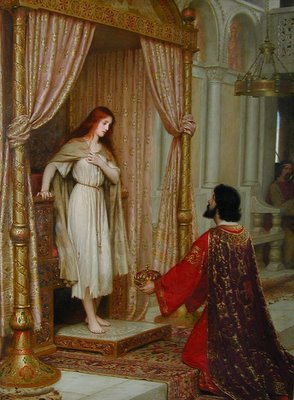 Edmund Blair Leighton (1853-1922) was a British Pre-Raphaelite painter. You may have heard of the term 'Pre-Raphaelite' before. Let me explain what it means.
Edmund Blair Leighton (1853-1922) was a British Pre-Raphaelite painter. You may have heard of the term 'Pre-Raphaelite' before. Let me explain what it means.The Pre-Raphaelites were a number of mostly British artists who emerged in the second half of the 19th Century with distinctive beliefs about aesthetics and style. Like the later Impressionists, they rejected the formal standards of Academic painting. In their view, the Academic emphasis on photographic realism and Greco-Roman subject matter had stifled imaginative art. This realism was typified by the precise anatomical depictions of Italian Renaissance artist Raphael. Rejecting this school of thought, the rebel artists called themselves the 'Pre-Raphaelites'. Famous members of this movement included Edward Burne-Jones, John Everett Millais, and Dante Gabriel Rossetti. The Pre-Raphaelites are massively popular in our time and can be found in countless prints and posters.
 Edmund Blair Leighton (as distinguished from Lord Frederick Leighton, an Academic painter from the same era) was fond of Medieval genre scenes, such as The Accolade. Idealizations of the Medieval era were common among the Pre-Raphaelites and heavily influenced J.R.R. Tolkein.
Edmund Blair Leighton (as distinguished from Lord Frederick Leighton, an Academic painter from the same era) was fond of Medieval genre scenes, such as The Accolade. Idealizations of the Medieval era were common among the Pre-Raphaelites and heavily influenced J.R.R. Tolkein.
Leighton was part of a revival of interest in Arthurian and Teutonic folklore. This painting is a depiction of the romantic couple Tristan and Isolde, which has taken the form a 12th Century poem, a Wagnerian opera, and an upcoming movie.
 The King and the Beggar Maid is a reference to a Medieval legend about a king named Cophetua who had no interest in women until he fell in love with a penniless beggar.
The King and the Beggar Maid is a reference to a Medieval legend about a king named Cophetua who had no interest in women until he fell in love with a penniless beggar.

2 comments:
Leighton has been a favorite of mine since back in my days as a picture framer. Wonderful sense of lighting, plus a true sense of drama in composition.
I'm not that fond of the Pre-Raphaelites in general because of the typical 2-dimensionality of their work, but Leighton is different. He brings out the majesty of the Arthurian drama.
Post a Comment